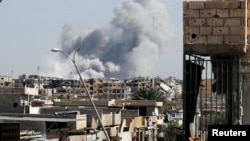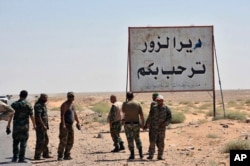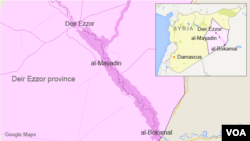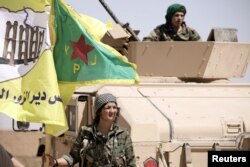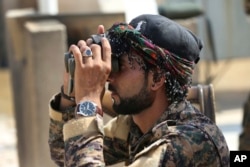U.S. President Donald Trump lambasted Iranian expansionism in the Middle East Friday when disavowing the international nuclear deal with Tehran, citing in particular Iran’s support for Syrian President Bashar al-Assad. But analysts charge his strategy to check Iran in the region remains inconsistent, especially when it comes to Syria.
In his statement announcing he’s withholding certifying Iran’s compliance with the nuclear agreement, known formally as the Joint Comprehensive Plan of Action (JCPOA), President Trump accused Tehran of fueling “sectarian violence in Iraq, and vicious civil wars in Yemen and Syria.”
He added: “In Syria, the Iranian regime has supported the atrocities of Bashar al-Assad’s regime.”
But U.S airstrikes have been helping Iranian-backed Shi’ite militias in Syria consolidate territorial gains by the Assad regime, and in recent weeks American-led coalition bombing raids have been assisting the militias, which are recruited, trained and directed by Iranian revolutionary guardsmen, to retake territory from the Islamic State militants in the province of Deir el-Zour, neighboring Iraq.
Inconsistent strategy
“There's certainly a lack of coherence in the Trump administration's policy with respect to Iran,” says Daveed Gartenstein-Ross, an analyst with the Foundation for the Defense of Democracies, a Washington-based policy research group. “This lack of coherence is reflective of the extraordinary complexity of the Syria/Iraq conflict, and also, in my view, of the great difficulty that the U.S. has in thinking strategically."
Last month, Syrian regime forces lifted a vicious 32-month IS siege of a loyalist enclave in Deir el-Zour city, marking a significant battlefield success. Since then the Syrian army and Shi’ite militias have been moving fast to advance in the wider oil-rich province as well as to oust IS militants from pockets in Deir el-Zour city itself.
On Saturday, Syrian military officials claimed government forces had retaken the town of Mayadin from IS militants, who appear to have abandoned their positions 44 kilometers southeast of Deir el-Zour city along the eastern bank of the Euphrates River after a week-long assault.
There are two simultaneous offensives against IS underway in Deir el-Zour with the Euphrates River acting as an informal demarcation line between them. The U.S.-backed Kurdish-dominated Syrian Democratic Forces (SDF) have been pushing north of the river, towards the border with Iraq; while the Assad forces have been advancing south of the Euphrates.
A moving wall of airstrikes by coalition warplanes well as Russian and Syrian jets have been helping the advances of both — but U.S. airstrikes have not been restricted to areas north of the Euphrates.
On Saturday, officials with the Combined Joint Task Force Operation Inherent Resolve reported coalition warplanes conducted three strikes near Abu Kamal, claiming to have destroyed an IS headquarters building.
On September 29, they reported that earlier in the month airstrikes had killed three IS drone experts near Mayadin as well as destroying a drone factory. “The removal of these key ISIS leaders disrupts and degrades ISIS’ ability to modify and employ drone platforms as reconnaissance and direct fire weapons on the battlefield,” said Coalition Spokesman Col. Ryan Dillon.
U.S.-led coalition airstrikes in eastern Syria have for several months targeted IS positions on the Syrian regime’s "side" of the unofficial demarcation line in Deir el-Zour city and elsewhere with Mayadin since April, often in the crosshairs as it appeared IS leaders were abandoning Raqqa and in effect moving the terror group’s de facto there.
In May, for example, coalition airstrikes targeted in two rounds of raids buildings housing IS fighters and their families in Mayadin, prompting criticism from rights groups because as many as 106 civilians, including 42 children, were killed.
Strange bedfellows
The latest phase in the long-running Syrian conflict is presenting a dizzying picture of strange bedfellows and temporary battlefield deals as sectarian groups, President Assad and overseas powers, including the United States, Russia and Iran, maneuver to gain an edge or to steer the war to a resolution.
The current maneuvering reflects the shifting priorities of external states as they try to shape an interim set of pre-settlement conditions, splitting the wrecked country into territorial zones of control, say analysts.
The map is becoming increasingly clear with Assad and his Iran-commanded Shi’ite allies controlling the west and center and parts of the east, the U.S.-backed Kurds the northeast of the country, and anti-Assad rebels bottled up in northern Idlib province and a small part of the south.
But the effect of the maneuvering in Syria, including U.S. actions there, pull away, say some analysts, from Trump’s stated policy aim of checking Iran’s expansion in the region. Trump’s Iran strategy “promises a new ‘balance of power’ in the region, but the main imbalance in the region is not in conventional forces but in Iran’s proxy militia presence in Syria, Iraq, Lebanon and Yemen,” says Paul Salem, an analyst at the Middle East Institute, a U.S.-based policy research group.
He complains there is no explanation about how “the U.S. plans to push back against this asymmetric warfare imbalance.”
Speaking last month at a think event in Washington, and before Trump’s disavowal of the Iran nuclear deal, U.S. national security adviser H.R. McMaster emphasized one of the Trump administration’s chief objectives is to block Iran and its proxy Hezbollah, the radical Lebanese Shi’ite militia, from consolidating their territorial gains in Syria as IS is defeated.
According to the Washington Post, when asked to articulate the plan to achieve that goal, he said, “I can’t tell you,” although he said there is strategy and it is “to weaken Iranian influence across the region broadly.” McMaster acknowledged the Assad offensive assisted by Iranian militias and Russian warplanes helps in the war against IS in the short term but remains hugely problematic in the longer term.
But for some, the administration has merely compounded the problem by withdrawing support from Syrian rebels battling to overthrow Assad and by assisting the Syrian regime when it is fighting IS.
Gartenstein-Ross blames not only the Trump administration for contradictions in Iran policy. “It is consistent rather than inconsistent with the Obama administration's approach. U.S. efforts to push back IS, in both the Obama and Trump administrations, has helped advance Iranian interests, in particular Iranian-backed militias.”




